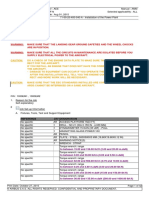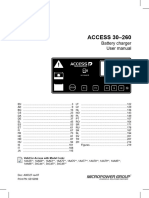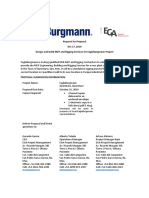IGNOU MCS-023 Solved Assignment 2016-17
IGNOU MCS-023 Solved Assignment 2016-17
Uploaded by
MaheshCopyright:
Available Formats
IGNOU MCS-023 Solved Assignment 2016-17
IGNOU MCS-023 Solved Assignment 2016-17
Uploaded by
MaheshOriginal Description:
Copyright
Available Formats
Share this document
Did you find this document useful?
Is this content inappropriate?
Copyright:
Available Formats
IGNOU MCS-023 Solved Assignment 2016-17
IGNOU MCS-023 Solved Assignment 2016-17
Uploaded by
MaheshCopyright:
Available Formats
For IGNOU Solved Assignments Visit : http://www.ignousolvedassignments.
com
T HE N E W S I G N O F S U C C E S S, W E P R O V I D E W H A T Y O U W A N
For More Ignou Solved Assignments Please Visit - www.ignousolvedassignments.com
Connect on Facebook :
http://www.facebook.com/pages/IgnouSolvedAssignmentscom/346544145433550
Subscribe and Get Solved Assignments Direct to your Inbox :
http://feedburner.google.com/fb/a/mailverify?uri=ignousolvedassignments_com
Request Any Solved Assignment at :
http://ignousolvedassignments.com/request-and-share-solved-assignments/ S
Course Code
MCS-023
Course Title
Introduction to Database Management Systems
Assignment Number
MCA (2)/023/Assign /12-13
Maximum Marks
: 100
Weightage
: 25%
Last Dates for Submission :
Session)
15th October, 2012 (For July 2012
15th April, 2013 (For January 2013
Session)
This assignment has five questions. Answer all questions of total 80
marks. Rest 20 marks are for viva voce. You may use illustrations and
diagrams to enhance explanations. Please go through the guidelines
regarding assignments given in the Programme Guide for the format
of presentation. Answer to each part of the question should be
confined to about 300 words
Question 1: Describe briefly all the possible applications of a database system in a
University?
For IGNOU Solved Assignments Visit : http://www.ignousolvedassignments.com
Ans:-There can be many applications of a database system can be possible like a university can
have colleges or study center, For example - like in IGNOU there are many regional center, which
have their study center's Enrollment No. of student managed by regional center as well as IGNOU
study center manages exams, particles, counseling sessions and attendance ,study material etc, So
we are creating a list of all applications which can be performed with university database system.
New Registration
Study center allotment
Study material details
Exam center details
Regional center details
Student results
Enquiry
For IGNOU Solved Assignments Visit : http://www.ignousolvedassignments.com
Question 2: Identify all the associated entities for a Study Centre Management System,their
corresponding attributes, relationships and cardinality and design an ER diagram for it.
Ans:-E-R Diagram
Student_ID
Student_name
Student_address
Student_enrol
Prog-id
Prog-code
Prog-name
Program
StudentDtls
enrolled
Faculty_ID
Course_ID
mark
have
attends
Practical
Courses
Theory
Attendance
Course_ID
Faculty_ID
Course_name
Attendance_ID
Course_code
Course_ID
Course_ID
Teach by
Remarks
Student_I
D
Faculties
Phone No.
Faculty_ID
Qualification
Faculty_name
Address
For IGNOU Solved Assignments Visit : http://www.ignousolvedassignments.com
Question 3: Consider the E-R diagram of Question 2 and design the tables. Perform
Normalization till the required normal form. Implement it using MS-Access. (25 Marks)
Ans:Program:Prog -Id
Integer
Prog -Code
varchar
Prog - Name
varchar
Create - date
Date
Student details:Stud -Id
Integer
Stud-Eno.
Big Integer
Stud- Name
varchar
Student Address
Varchar
Create - date
Date
Courses:Course -Id
Integer
Course-Code
varchar
Course - Name
varchar
Create - date
Date
Attendance:Attendance-Id
Integer
Course-Code
Integer
Stud-Id
Integer
Create - date
Date
Remarks
Varchar
For IGNOU Solved Assignments Visit : http://www.ignousolvedassignments.com
Faculties:Faculty-Id
Integer
Faculty-Name
Integer
Faculty-Add
Integer
Qualification
Date
Phone No.
Varchar
Create-date
Varchar
Question 4: Consider a "Project Management System" that maintains the database using the
following tables: (10 Marks)
Project (pid, ptitle, startdate, enddate, duration_in_months, cid, Cost)
Clients (cid, cname, caddress, cphone)
Employee (eid, name, address, phone)
Project-person (pid, eid)
Please note that an employee may be working on more than one project in the organization
at any given time. Write and run the following SQL queries on the tables:
Ans:Create table Project(Pid Integer primary key,ptille varchar(50),startdate Date,enddate
Date,duration-in-months Integer,cid Int ,cost int);
Create table clients (cid int Primary key,cname varchar(50),c-address varchar(50),c-phone BigInt);
Create table Employee(eid Int Primary key, name varchar(50),address varchar(50),phone BigInt);
Create table Project-Person(Pid Int,cid Int);
For IGNOU Solved Assignments Visit : http://www.ignousolvedassignments.com
a) Find the cid and cname of the clients who have given only one project to the company.
Ans:- Select cid ,cname from clients INNER JOIN Project ON clients.cid=project.cid WHERE
cid=(select count(cid)from Project);
(b) List the details of all the employees whoever are working on the project with project code
(pid) = 111.
Ans:- Select * from Employee INNERJOIN Project-Person ON Employe.eid=Project-Person.eid
WHERE Project-Person.pid=111;
(c) List all the project details those are currently under development.
Ans:- Select * from Project WHERE end-date=NULL;
(d) Find the projects whose cost is more than 11 lakhs.
Ans:- Select * from Project WHERE cost>11,00,000;
(e) Find the employee who is not working on any of the project. Note: Make suitable
assumptions, if any.
Ans:- Select * from Employee INNER JOIN Project-Person ON Employee.eid=Project-Person.eid
WHERE Employee.eid NOT NULL
Question 5: Consider the Relation R={A, B, C, D, E, F, G, H } and the set of functional
dependencies.
A C B CG
AD EH
C DF
A H
What is the key for R? Decompose R into 2NF, 3NF and finally in BCNF relation.
Ans:-A functional dependency (FD) is a constraint between two sets of attributes in a relation
from a database.
Given a relation R, a set of attributes X in R is said to functionally determine another attribute Y,
also in R, (written X
Y) if, and only if, each X value is associated with precisely one Y value. Customarily
we call X the determinant set and Y the dependent attribute. Thus, given a tuple and the values of
the attributes in X, one can determine the corresponding value of the Y attribute. In simple words,
if X value is known, Y value is certainly known. For the purposes of simplicity, given that X and Y
are sets of attributes in R, X
Y denotes that X functionally determines each of the members of Yin this
case Y is known as the dependent set. Thus, a candidate key is a minimal set of attributes that
functionally determine all of the attributes in a relation. The concept
For IGNOU Solved Assignments Visit : http://www.ignousolvedassignments.com
of functional dependency arises when one attribute is dependent on another attribute and it also
uniquely determines the other attribute.
(Note: the "function" being discussed in "functional dependency" is the function of identification.)
A functional dependency FD: X
Y is called trivial if Y is a subset of X.
The determination of functional dependencies is an important part of designing databases in the
relational model, and in database normalization and demoralization. The functional dependencies,
along with the attribute domains, are selected so as to generate constraints that would exclude as
much data inappropriate to the user domain from the system as possible.
For example, suppose one is designing a system to track vehicles and the capacity of their engines.
Each vehicle has a unique vehicle identification number (VIN). One would write VIN
EngineCapacity because it would be inappropriate for a vehicle's engine to have more than one
capacity. (Assuming, in this case, that vehicles only have one engine.) However, EngineCapacity
VIN, is incorrect because there could be many vehicles with the same engine capacity.
This functional dependency may suggest that the attribute EngineCapacity be placed in a relation
with candidate key VIN. However, that may not always be appropriate. For example, if that
functional dependency occurs as a result of the transitive functional dependencies VIN
VehicleModel and VehicleModel
EngineCapacity then that would not result in a normalized relation. a
relation is in BOC normal form if all its determinant are candidate keys, in other words each
determinant can be used as a primary key. Because relation R has only one determinant (a, b, c),,
which is the composite primary, key and since the primary is a candidate key therefore R is in BOC
normal form.
Now R may or may not be in fourth normal form.
1. If R contains no multi value dependency then R will be in Fourth normal form.
2. Assume R has the following two-multi value dependencies:
a ------->> b and
a ---------->> c
In this case R will be in the fourth normal form if b and c dependent on each other. However if
b and c are independent of each other then R is not in fourth normal form and the relation has
to be projected to following two non-loss projections. These non-loss projections will be in fourth
normal form.
For IGNOU Solved Assignments Visit : http://www.ignousolvedassignments.com
Example:
Case 1:
Assume the following relation:
Employee (Eid:pk1, Language:pk2, Skill:pk3)
No multi value dependency, therefore R is in fourth normal form.
case 2:
Assume the following relation with multi-value dependency:
Employee (Eid:pk1, Languages:pk2, Skills:pk3)
Eid ---->> Languages
Eid ------>> Skills
Languages and Skills are dependent.
This says an employee speak several languages and has several skills. However for each skill
a specific language is used when that skill is practiced.
Eid
Language
S k ill
100
English
Teaching
100
Kurdish
Politic
100
French
cooking
200
English
cooking
200
Arabic
Singing
Thus employee 100 when he/she teaches speaks English but when he cooks speaks French.
This relation is in fourth normal form and does not suffer from any anomalies.
case 3:
Assume the following relation with multi-value dependency:
Employee (Eid:pk1, Languages:pk2, Skills:pk3)
Eid ---->> Languages
Languages and Skills are independent.
Eid ------>> Skills
For IGNOU Solved Assignments Visit : http://www.ignousolvedassignments.com
Eid
Language
S k ill
100
English
Teaching
100
Kurdish
Politic
100
English
politic
100
Kurdish
Teaching
200
Arabic
Singing
This relation is not in fourth normal form and suffers from all three types of anomalies.
Insertion anomaly: To insert row (200 English Cooking) we have to insert two extra rows
(200 Arabic cooking), and (200 English Singing) otherwise the database will be inconsistent.
Note the table will be as follow:
Eid
Language
S k ill
100
English
Teaching
100
Kurdish
Politic
100
English
politic
100
Kurdish
Teaching
200
Arabic
Singing
200
English
Cooking
200
Arabic
Cooking
200
English
Singing
Deletion anomaly: If employee 100 discontinue politic skill we have to delete two rows
(100 Kurdish Politic), and (100 English Politic) otherwise the database will be inconsistent.
Update anomaly: If employee 200 changes his skill from singing to dancing we have to make
changes in more than one place
The relation is projected to the following two non-loss projections which are in forth normal form
For IGNOU Solved Assignments Visit :
http://www.ignousolvedassignments.com
Emplyee_Language(Eid:pk1, Languages:pk2)
Eid
Language
100
English
100
Kurdish
200
Arabic
Emplyee_Language(Eid:pk1, Skills:pk2)
Eid
S k ill
100
Teaching
100
Politic
200
Singing
For IGNOU Solved Assignments Visit :
http://www.ignousolvedassignments.com
You might also like
- Infosys Dbms Question AnswerDocument27 pagesInfosys Dbms Question AnswerUddipto Sen100% (1)
- Airbus A320 Inst Power Plant PDFDocument42 pagesAirbus A320 Inst Power Plant PDFPinaki GhoshNo ratings yet
- Advanced C++ Interview Questions You'll Most Likely Be AskedFrom EverandAdvanced C++ Interview Questions You'll Most Likely Be AskedNo ratings yet
- Numerical Method For Engineering-Chapter 1Document16 pagesNumerical Method For Engineering-Chapter 1Mrbudakbaek100% (1)
- Thenewsignofsuccess, Weprovidewhatyouwan: For More Ignou Solved Assignments Please VisitDocument11 pagesThenewsignofsuccess, Weprovidewhatyouwan: For More Ignou Solved Assignments Please Visitvjsahani0% (2)
- CSCI235 Database Systems Assignment 1Document12 pagesCSCI235 Database Systems Assignment 1Mariam MobeenNo ratings yet
- CS 15900 Credit ExamDocument18 pagesCS 15900 Credit ExamnnNo ratings yet
- Database Mangement SystemsDocument59 pagesDatabase Mangement SystemsUjwal mudhirajNo ratings yet
- Oracle Dumps PDFDocument6 pagesOracle Dumps PDFindira selvarajNo ratings yet
- HW 1Document4 pagesHW 1Nirtyanath JaganathanNo ratings yet
- Quiz AnPSiDocument2 pagesQuiz AnPSiWi ChenNo ratings yet
- Data Structures and Algorithms Assig 1 Fall21Document10 pagesData Structures and Algorithms Assig 1 Fall21Jude Yassin0% (1)
- 18BCS33C U3Document142 pages18BCS33C U3rajkumar184No ratings yet
- Full 4858 All ChaptersDocument54 pagesFull 4858 All Chapterskamuroshuky100% (9)
- Cs 2203 Object Oriented Programming Question Bank-ActDocument83 pagesCs 2203 Object Oriented Programming Question Bank-ActactvenkatesanNo ratings yet
- Database Management System: Important Questions Unit-1Document9 pagesDatabase Management System: Important Questions Unit-1Aniket KaushikNo ratings yet
- Cs6202 Pds 1 Notes RejinpaulDocument228 pagesCs6202 Pds 1 Notes RejinpaulbalabooksNo ratings yet
- 1350 Ass2 Qns PDFDocument5 pages1350 Ass2 Qns PDFCliff EvansNo ratings yet
- Interview Questions With AnswersDocument11 pagesInterview Questions With AnswersAyalNo ratings yet
- 278Document98 pages278pankajusbNo ratings yet
- Programming in C++ For BCA BIT BEDocument0 pagesProgramming in C++ For BCA BIT BEwww.bhawesh.com.npNo ratings yet
- Oracle Fusion &EBS Technical ConsultantDocument6 pagesOracle Fusion &EBS Technical ConsultantChaitanya AlavalapatiNo ratings yet
- Viva Questions-Cpp-CbseDocument5 pagesViva Questions-Cpp-Cbsekhyati007100% (1)
- LAB ACTIVITY 3: Entity Relationship (ER) Model & Normalization - Part 1Document15 pagesLAB ACTIVITY 3: Entity Relationship (ER) Model & Normalization - Part 1anon_783732319100% (2)
- 2020 Solved DBMSDocument15 pages2020 Solved DBMSBen JohnsonNo ratings yet
- La3 1Document3 pagesLa3 1Hega SiniNo ratings yet
- Evolution of Programming Methodologies and Consepts of OopDocument48 pagesEvolution of Programming Methodologies and Consepts of OopSoumya Vijoy100% (1)
- CBAP Sample QuestionsDocument24 pagesCBAP Sample Questionsricha9910No ratings yet
- HFM 11 Essentials CertificationDocument23 pagesHFM 11 Essentials Certificationbonnn_1No ratings yet
- Ch-2 Query Processing and OptimizationDocument21 pagesCh-2 Query Processing and Optimizationsefuasfaw021No ratings yet
- CW COMP1556 28 Ver1 1617Document6 pagesCW COMP1556 28 Ver1 1617dharshinishuryaNo ratings yet
- Designing A Database OkDocument13 pagesDesigning A Database OkkayisledestaNo ratings yet
- PHP Interview Question & AnswerDocument36 pagesPHP Interview Question & AnswerSanjeev KumarNo ratings yet
- 24CS101 Unit - IiDocument89 pages24CS101 Unit - Ii23102208No ratings yet
- Curriculam Vitae: Qualification University/college Aggregate % Year of Pass OutDocument3 pagesCurriculam Vitae: Qualification University/college Aggregate % Year of Pass OutaravindkasarapuNo ratings yet
- C++ Interview Questions (Frequently Asked) : For Free Interview Preparation Check The Links BelowDocument19 pagesC++ Interview Questions (Frequently Asked) : For Free Interview Preparation Check The Links BelowPranjal JalanNo ratings yet
- Unit 1 Object Oriented Programming FundamentalsDocument43 pagesUnit 1 Object Oriented Programming FundamentalsShyam SundarNo ratings yet
- PHP Interview Question & AnswerDocument32 pagesPHP Interview Question & Answermnsy2005No ratings yet
- 24CS101 Unit - IDocument143 pages24CS101 Unit - I23102208No ratings yet
- MCS-043 Solved AssignmentsDocument34 pagesMCS-043 Solved AssignmentsnikitaNo ratings yet
- JF 22-23 T2 COMP11007 Coursework Assignment Amended 03feb2023 Then On 20mar2023Document5 pagesJF 22-23 T2 COMP11007 Coursework Assignment Amended 03feb2023 Then On 20mar2023Bakchod InsaanNo ratings yet
- Assignment 1 DbmsDocument5 pagesAssignment 1 DbmsEkansh GuptaNo ratings yet
- SE Duc MLDocument8 pagesSE Duc MLVõ Minh KiệtNo ratings yet
- Internship Training ReportDocument8 pagesInternship Training ReportLs VaideeswariNo ratings yet
- 1Z0 982 DemoDocument7 pages1Z0 982 DemoPrashantRanjan2010No ratings yet
- Application Development and Emerging Technology Complete Key AnswersDocument71 pagesApplication Development and Emerging Technology Complete Key AnswersjusipragasNo ratings yet
- COMPRO2 SyllabusDocument4 pagesCOMPRO2 SyllabusMatthew SorianoNo ratings yet
- Adms 2Document20 pagesAdms 2suraj nathNo ratings yet
- CSE 566 Assignment 5Document13 pagesCSE 566 Assignment 5sampathswaroopthegamerNo ratings yet
- Practical On RDBMSDocument58 pagesPractical On RDBMSPankaj DadhichNo ratings yet
- Chap - OPPS CONCEPTDocument44 pagesChap - OPPS CONCEPTAmisha DalalNo ratings yet
- C Byregowda Institute of TechnologyDocument2 pagesC Byregowda Institute of Technologypriya shashikumarNo ratings yet
- MCS-014 Systems Analysis and DesignDocument30 pagesMCS-014 Systems Analysis and DesignSumit RanjanNo ratings yet
- Oracle Dumps 1z0-418Document92 pagesOracle Dumps 1z0-418MosunmolaNo ratings yet
- Associate Reactive Developer DemoDocument5 pagesAssociate Reactive Developer DemoFaisal AbdullahNo ratings yet
- PL 400 PDFDocument54 pagesPL 400 PDFXphidaNo ratings yet
- Java / J2EE Interview Questions You'll Most Likely Be AskedFrom EverandJava / J2EE Interview Questions You'll Most Likely Be AskedNo ratings yet
- Salesforce.com Interview Q & A & Certification Question Bank with AnswersFrom EverandSalesforce.com Interview Q & A & Certification Question Bank with AnswersRating: 4 out of 5 stars4/5 (5)
- BW StatisticsDocument6 pagesBW StatisticsDevesh VarshneyNo ratings yet
- Reduction of Live Loads and ACI Coefficient: Structural TheoryDocument6 pagesReduction of Live Loads and ACI Coefficient: Structural TheoryAllan Añavisa Ostique Jr.No ratings yet
- Modeling and Simulation of Four-Bar Planar Mechanisms Using AdamsDocument7 pagesModeling and Simulation of Four-Bar Planar Mechanisms Using AdamsIAEME PublicationNo ratings yet
- ACCESS 30-260 User Manual Doc A00327 - Rev07 PN 6515099 Color - 2023-10-20Document225 pagesACCESS 30-260 User Manual Doc A00327 - Rev07 PN 6515099 Color - 2023-10-20jads301179No ratings yet
- PID Vs Fuzzy LogicDocument30 pagesPID Vs Fuzzy LogicPrem ShahNo ratings yet
- Data Sheet 544JDocument4 pagesData Sheet 544JjricpelNo ratings yet
- Chapter 8 Two-Dimensional Problem SolutionDocument51 pagesChapter 8 Two-Dimensional Problem SolutionUNsha bee kom100% (1)
- Tunnel Diode - Definition, Symbol, and WorkingDocument16 pagesTunnel Diode - Definition, Symbol, and WorkingdevchandarNo ratings yet
- Abap Code BookDocument66 pagesAbap Code BookDineshkumar AkulaNo ratings yet
- Mad A Suvari PalemDocument14 pagesMad A Suvari PalemD.V.Srinivasa RaoNo ratings yet
- MX Road Part1Document289 pagesMX Road Part1Vinay Yadav100% (3)
- Hella 8D Report - Supplier Training MaterialDocument42 pagesHella 8D Report - Supplier Training MaterialThamizhanban RNo ratings yet
- I AM AERO Mi-171Document18 pagesI AM AERO Mi-171pilot digitalNo ratings yet
- RFP EagleBurgmann Rev.01 PDFDocument6 pagesRFP EagleBurgmann Rev.01 PDFAnzeljaegNo ratings yet
- Cylinder Storage: Table 6.3 Area Classification of Cylinder Filling and Cylinder Storage FacilitiesDocument1 pageCylinder Storage: Table 6.3 Area Classification of Cylinder Filling and Cylinder Storage FacilitiesmeeNo ratings yet
- TechnicalitistDocument23 pagesTechnicalitistTahiru SakaNo ratings yet
- Sm3 07 C Service ManualDocument36 pagesSm3 07 C Service ManualYashveerNo ratings yet
- Dana Childs ResumeDocument3 pagesDana Childs Resumeapi-244892435No ratings yet
- JBG-12LX: Addressable Manual Pull StationDocument2 pagesJBG-12LX: Addressable Manual Pull StationJosë RodríguezNo ratings yet
- Assessment 1 - Critical Review: Case Study 1: School of Computing, Engineering and Mathematics Western Sydney UniversityDocument10 pagesAssessment 1 - Critical Review: Case Study 1: School of Computing, Engineering and Mathematics Western Sydney Universityanon_805511293No ratings yet
- Jntu Aeronautical Engineering R05 Syllabus BookDocument60 pagesJntu Aeronautical Engineering R05 Syllabus BookARUN.A.J NAIR100% (1)
- Automative TextilesDocument31 pagesAutomative Textilesrahulraheja8100% (1)
- Kubota l2350dt Steering PartsDocument10 pagesKubota l2350dt Steering PartsFortuna Favet FortibusNo ratings yet
- VD4G Generator Circuit Breaker: Small Footprint, Full Protection For Generator ApplicationsDocument2 pagesVD4G Generator Circuit Breaker: Small Footprint, Full Protection For Generator ApplicationsFransis Chandra KusumaNo ratings yet
- Internet Options - Add or Remove Connections Tab - Windows 7 Help ForumsDocument7 pagesInternet Options - Add or Remove Connections Tab - Windows 7 Help ForumsMarko CvijovicNo ratings yet
- BNBC-2006 WIND CalculationDocument7 pagesBNBC-2006 WIND CalculationJahidul Islam0% (1)
- Lesson 1 - SolidWorks Basics and The User Interface PDFDocument20 pagesLesson 1 - SolidWorks Basics and The User Interface PDFhaziqismail100% (2)
- Digital Logic RTL & Verilog Interview Questions PreviewDocument34 pagesDigital Logic RTL & Verilog Interview Questions Previewkoushikroopa hk71% (7)

























































































